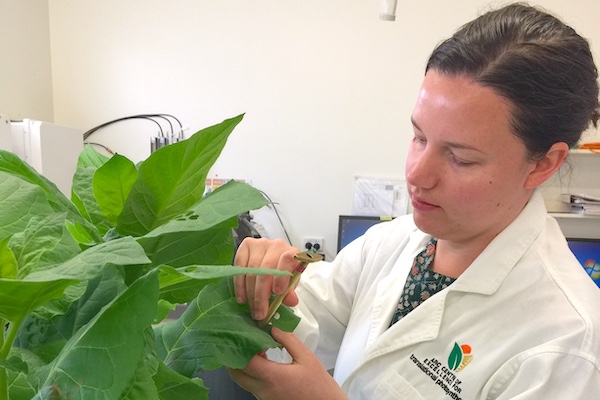Modifying photosynthesis has increasingly been a research target to improve crop yields to feed a growing global population in the face of climate change and other environmental factors. In a recent study, published in the Journal of Experimental Botany, a team from the Australian National University (ANU) investigated the effects of increasing the amount of carbon dioxide channels in plant membranes, but could not detect any impact on photosynthesis in model tobacco plants.
Photosynthesis relies on a supply of carbon dioxide (CO2) to the chloroplasts within leaf cells, where it is fixed into sugars by the enzyme Rubisco. To get to the chloroplast, CO2 must diffuse into the leaf and through the leaf mesophyll cells, crossing barriers such as cell walls and membranes. Increasing CO2diffusion through mesophyll cells into the chloroplast (termed mesophyll conductance) will improve photosynthesis–boosting yields in crops while also improving water-use efficiency.
“Our research targeted the membranes in leaf cells; we wanted to know if we could make CO2 transfer more efficient by adding extra channels for CO2 diffusion into cell membranes,” said RIPE researcher Dr Tory Clarke, who performed this study at ANU.
To target CO2 transfer across plant cell membranes, the team at ANU increased the amount of aquaporin proteins in the plasma membranes of test tobacco plants.
Senior author Dr Michael Groszmann explained, “Aquaporins are membrane channels that can facilitate the movement of molecules such as water and gasses across membranes. Our research confirms that the channels localize in the leaf cell plasma membrane.”
Previous studies have established that in test systems, a subset of plant aquaporins, the Plasma-membrane Intrinsic Proteins (PIPs) have CO2 transfer capabilities, but there have been conflicting reports about their role in mesophyll conductance in the plant. “In this study, we were able to introduce more PIP aquaporin channels into the mesophyll cell membrane, but surprisingly this did not detectably increase the conductance of CO2 through the mesophyll cell, with no effect on photosynthetic rates either,” said Clarke.
“Plant growth and environmental conditions may play a significant role in the ability of aquaporins to alter mesophyll conductance,” said Susanne von Caemmerer, a Professor of Molecular Plant Physiology at the Research School of Biology at the ANU, who led this study alongside Groszmann. “Our study also used computer modeling to predict how changes to membrane CO2 permeability would impact overall mesophyll conductance. We found that in order to improve overall mesophyll conductance by 20%, the amount of CO2 that would need to cross the plant cell membrane would need to double.”
While improved photosynthesis was not realized in this study, this research provides increased understanding of the movement of CO2 from atmosphere to chloroplast.
“Taking what we’ve learned in this study, we can now focus our work on gaining a better understanding of aquaporin function and how we can improve mesophyll conductance and photosynthesis,” said Groszmann.
This work is part of Realizing Increased Photosynthetic Efficiency (RIPE), an international research project aims to increase global food production by developing food crops that turn the sun’s energy into food more efficiently with support from the Bill & Melinda Gates Foundation, Foundation for Food & Agriculture Research, and U.K. Foreign, Commonwealth & Development Office.
RIPE is led by the University of Illinois in partnership with The Australian National University, Chinese Academy of Sciences, Commonwealth Scientific and Industrial Research Organisation, Lancaster University, Louisiana State University, University of California, Berkeley, University of Cambridge, University of Essex, and U.S. Department of Agriculture, Agricultural Research Service.
Read the paper: Journal of Experimental Botany
Article source: RIPE
Author: Amanda Nguyen
Image: Dr. Tory Clarke. Credit: ANU/RIPE project








